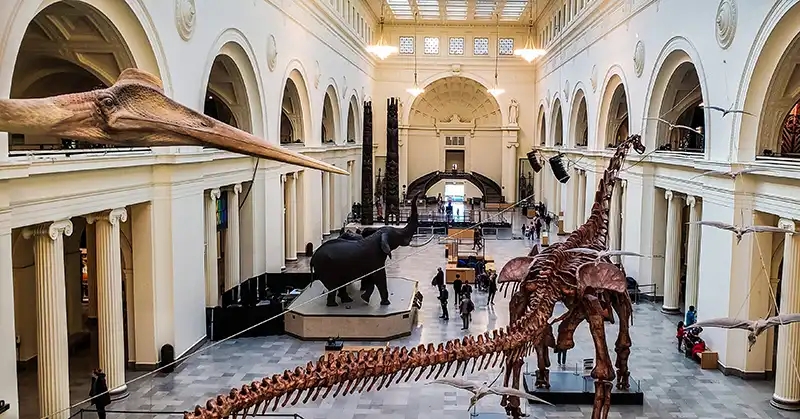
Visitors to the Field Museum in Chicago, Illinois, start out “big” with Máximo, one of the largest dinosaurs ever discovered. At 122 feet across and 28 feet tall at the head, this Titanosaur is amazing! And he’s just the start of great things to come in Chicago’s natural history museum.
What’s in the Field Museum?
The Field Museum in Chicago opened to the public in 1894, with its starter collection from the 1893 World’s Columbian Exposition. Its current location in Grant Park was built to house the ever-growing museum collection, opening in 1921.
Fast Fact: Crocodiles and palm trees once covered Wyoming. Indeed, 50 million years ago warm climates reached from pole to pole! Field Museum fossils in one room provide a snapshot of a Wyoming tropical lake called Fossil Lake.
The collection grew through the 1900s as a result of expeditions conducted by four scientific departments. Where to? North, Central and South America, and Africa.
While the dinosaur, Máximo, is a giant, he’s small in comparison to the museum. It spreads out over nearly half-a-million square feet on the Ground, Main and Upper levels, and houses nearly 40 million artifacts!

What’s in the Evolving Planet dinosaur collection in the Field Museum?
The Field Museum is home to many different types of dinosaurs. In fact, the museum is considered to have one of the world’s best dinosaur museums.
Sue, the T-Rex, is one of its most important inhabitants. The dinosaur is named after Sue Hendrickson, who discovered its bones near Faith, South Dakota in 1990. What makes Sue famous though, is that it’s the most complete and physically largest T-Rex found to date.
So, how big is Sue the T-Rex? Forty feet long and thirteen feet tall at the hip.
There are also dozens of other dinosaurs from North America and as far away as Argentina and Antarctica. They include:
- Brachiosurus from 1900 in western Colorado
- Apatosaurus from Colorado and Utah
- Triceratops from 1904 in Montana
- Gorgosaurus found shortly after WWI, but not prepared until 1999
- Lambeosaurus found in Alberta in 1922
- Daspletosaurus (aka Gorgeous George) in Alberta in 1914
- Parasaurolophus from New Mexico in 1923
- Cryolophosaurus from the Antarctic in 1991
- Rapetosaurus from Madagascar in 2001
Learn more about the dinosaurs of the Field Museum on Extinct Monsters.
What permanent exhibits are in the Field Museum?
The Field Museum has a number of permanent exhibits that have grown out of its expeditions and artifact collecting. While the Evolving Planet may be one of the most popular, you’ll also find:
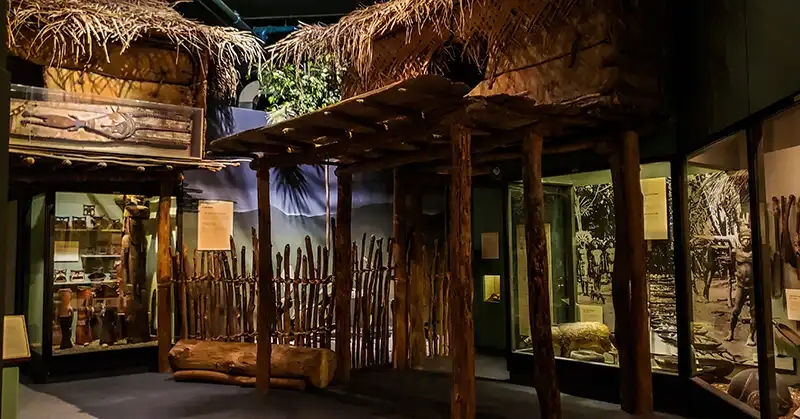
- The Ancient Americas – includes artifacts from totem poles to an 800-year-old pueblo.
- Inside Ancient Egypt Display – from a 4000-year-old boat to 23 human mummies.
- Cyrus Tang Hall of China – step back through China’s history in five galleries with everything from burial objects to paintings.
- Grainger Hall of Gems featuring a 5,890-carot topaz and more.
- Underground adventure – you guessed it – all about the bugs!
- Crown Family PlayLab – a hands-on experience for young explorers.
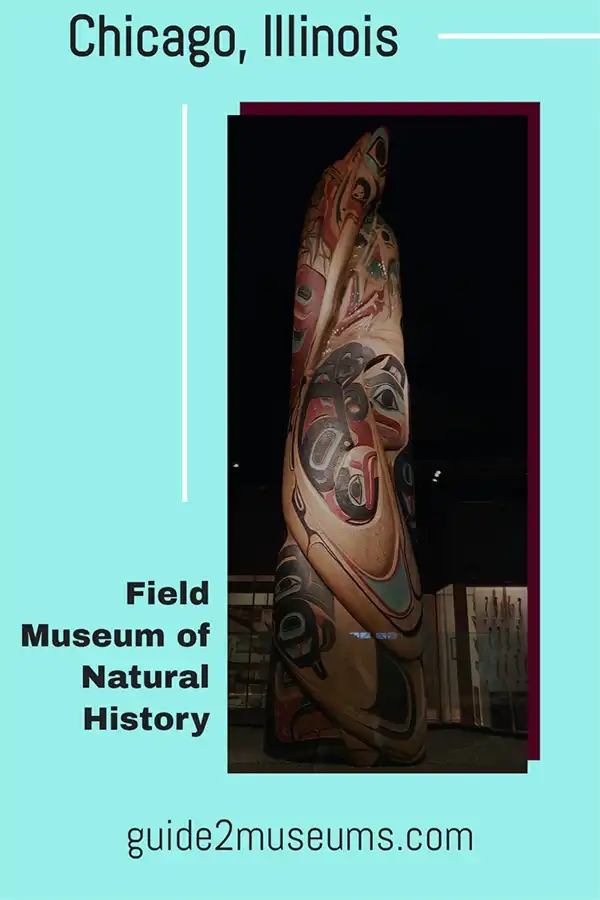
Linda’s Pick of the Displays
The Field Museum is the best natural museum I’ve ever visited! So, it was hard to pick a favorite part, so I selected two. I’ll start with the curation of earth’s mass extinctions, which impressed me the most.

By studing and displaying geological and fossil records, the Field Museum builds a timeline of life on earth — very little of which is as we know it. Indeed, evolutionary changes started about 445 million years ago with the Orovician Extinction.
You may be surprised to know (I sure was) that the end of the Age of Dinosaurs was actually Extinction Event #5. It was, as scientists now agree, an asteroid crashing into earth about 66 million years ago.
How do they know it was an asteroid? From iridium found in rocks dating to the time of the extinction.
And that takes us to Extinction Event #6, the Holocene Extinction, which we’re living in.
Indeed, the Holocene Extinction is attributed to human activity. And while yes, we’re still here, many species no longer exist.
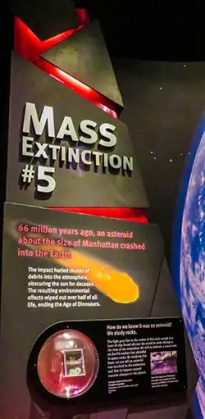
You can read (and watch a video) more about the six extinction events in this American Museum of Natural History article: Shelf Life 12: Six Extinctions in Six Minutes.
Horses in North America
Fast Fact! Early horses were found in Wyoming dating back 56 million years, while more evolved horses have been found on the grasslands of South Dakota from 33 to 5 million years ago. However, horses nearly disappeared and were reintroduced in the 1500s by Cortez, then spread across North America through Indigenous tribes.
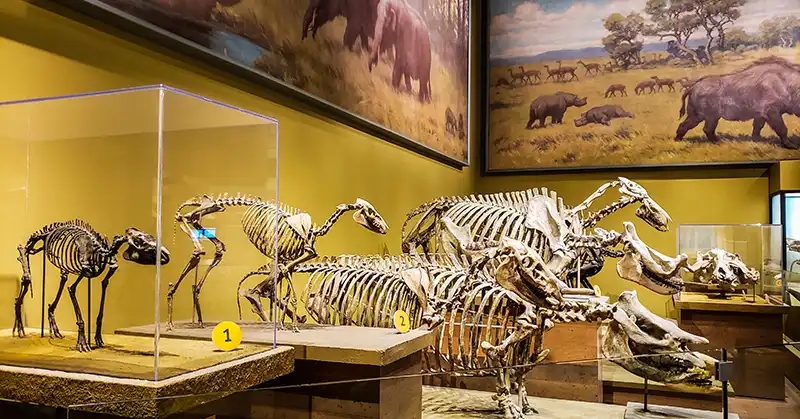
This history of horses was particularly interesting to me because I grew up on a horse ranch — the QAR, or Qu’Appelle Appaloosa Ranch.
Linda’s Road Trip Tips
I visited the Field Museum midway through an Amtrak train adventure. It started in New Orleans, taking the “City of New Orleans” Amtrak to Chicago. In Chicago, I changed trains to the Amtrak Empire Builder. There, I had a six-hour break before boarding for Williston, North Dakota, where David picked me up the next day at noon.
I found the Chicago Amtrak Union station very busy! There’s a place to check luggage, so I was able to drop it off before getting an Uber to the museum. Coming back, I only ubered as far as the Bridgehouse Museum, then took an amazing walk along the Chicago Riverwalk.

Back at Union Station, I found one of the few empty seats where I could enjoy a cold drink and some lunch. My choice — a stromboli, which I’d never eaten before.
A type of pizza, I found the stromboli very tasty!
Who Should Visit the Field Museum?
Seriously, this is a must-see museum for everyone! With more than a century’s worth of artifacts collected from around the world, it’s a journey through time and place.
The Field Museum has everything visitors could possibly need, from free wi-fi to a nursing room for moms and babies to free wheelchairs. It is, of course, fully accessible for those who have mobility issues.

How Do You Visit the Field Museum?
The Field Museum in located in Chicago, Illinois, at 1400 S. Dusable Lake Shore Drive.

Field Museum website.
Check museum days and hours to plan your visit to the Field Museum.
Keep up-to-date with the Field Museum Facebook page.
Take a virtual tour of the Field Museum on YouTube.
Plan your visit to the Chicago Field Museum with Google Maps.
Explore More Science Museums
- Review For Museum Of Illusions Toronto & How To Visit
 The Toronto Museum of Illusions has 80+ interactive displays. Visit this Canadian attraction to learn fun science facts.
The Toronto Museum of Illusions has 80+ interactive displays. Visit this Canadian attraction to learn fun science facts. - Chicago’s Natural History Field Museum Review & How To Visit
 The century-old Chicago Field Museum has a natural history collection. It includes one of the largest dinosaurs ever discovered along with century-old cultural artifacts from around the worl.
The century-old Chicago Field Museum has a natural history collection. It includes one of the largest dinosaurs ever discovered along with century-old cultural artifacts from around the worl. - Fascinating Bug Facts! New Orleans Museum
 There’s more to bugs than you might imagine! Discover all kinds of fascinting things about insects at New Orleans’ Audubon Insectarium Science Museum.
There’s more to bugs than you might imagine! Discover all kinds of fascinting things about insects at New Orleans’ Audubon Insectarium Science Museum. - Astonishing Potato Facts in an Idaho Museum
 Potatoes are a staple in North America and Idaho’s Potato Museum is in the world’s potato capital. Discover history and fun facts about potatoes.
Potatoes are a staple in North America and Idaho’s Potato Museum is in the world’s potato capital. Discover history and fun facts about potatoes.







